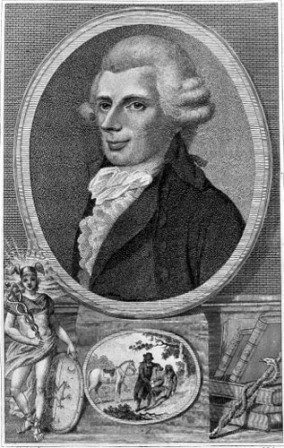Solomon's Secret Arts (2 page)
Read Solomon's Secret Arts Online
Authors: Paul Kléber Monod

3
The astrological man from John Gadbury's almanac
ΕΩΗΜΕΡΙΣ
for 1668. The moon as it passes through each zodiacal sign governs a different body part. At the bottom of the page is an advertisement for a mathematical instrument maker. The facing page, not shown here, contains a table of “dignities,” or the celestial mansions and houses in which the planets were located, along with advertisements: for a bookseller who marketed both ink and toothpaste, and for a table of astrological houses designed for “the ingenious Arti[st]s in Astrologie.”

4
A portrait of John Heydon, from his book
Theomagia: Or, The Temple of Wisdom
(1664). Richly attired and surrounded by his own books, he basks in celestial rays. Below the portrait is a coat of arms that marks him as an Esquire. The planetary signs that surround him form a kind of nativity chart. At the bottom left, an obedient dog labeled “Lilly” bows towards the “Astromagus.”
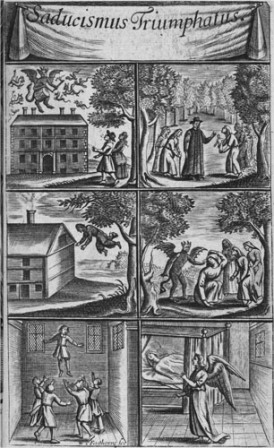
5
The frontispiece to the second part of Joseph Glanvill's
Saducismus Triumphatus
shows the Devil carrying out various types of mischief, including levitation. The drummer of Tedworth is at the upper left, and at the lower right, an angel appears to a disabled girl in Amsterdam, who is cured of her affliction. Evidently, some spirits can be benign, but human beings cannot enter into voluntary contact with them.
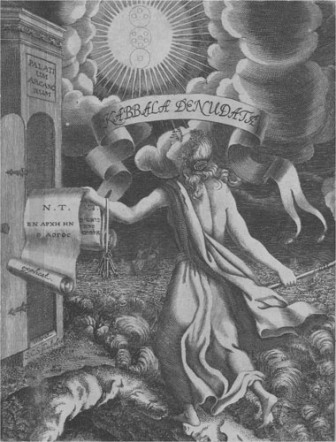
6
A ray of celestial light directly illuminates the sight of a young woman as she enters the Palace of Secrets, which resembles a mausoleum or perhaps the outer gate to Solomon's Temple. Running through parted waters, she carries both the Old and the New Testaments as well as a set of keys and a fading torch. To entice alchemists further, all four elements are represented in this frontispiece to
Kabbala Denudata
. The ocean rolls back to reveal the earth just as the cloudy skies break up to reveal the fiery sun.
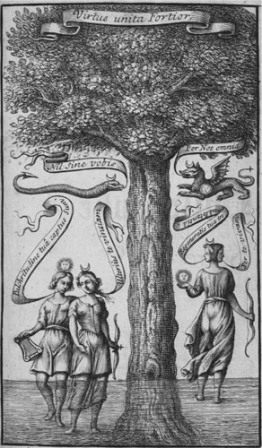
7
Gold and silver, personified in the gods Apollo (the sun) and Diana (the moon), stand knee-deep in a watery solution beneath the Tree of Life in the frontispiece to the alchemical aphorisms of Baro Urbigerus. Above them are a serpent and a winged dragon, symbols of mercury in the alchemical process. At the right, the two divine beings have been combined into a single, hermaphroditic figure.
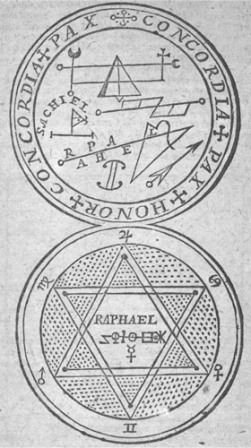
8
The sigil whose sale by the astrologer Henry Coley in 1698 was so vehemently denounced by John Partridge in his almanac. The Cherubim Sachiel or Zadkiel is mentioned in the Kabbala and was associated with the planet Jupiter, while Raphael appears in the Biblical Book of Tobit and is linked, as here, with the planet Mercury.

9
The Temple plan from Newton's
Chronology
. West is at the top of the print. The outer court or Court of the People surrounds an inner wall, containing the Court of the Priests and the Temple proper. The altar, marked “G,” is at the centre of the Court of the Priests, in front of the Temple porch, which is supported by the two legendary pillars named Jachin and Boaz. The letter “O” marks the Holy of Holies, surrounded by the Treasure Chambers—filled, perhaps, with the fruits of Solomon's alchemy.
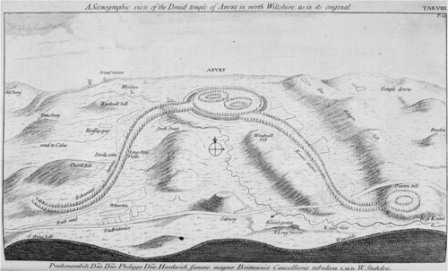
10
William Stukeley's conception of Avebury as a winged serpent is clearly represented in this engraving from
Abury, A Temple of the British Druids
(1743). The head of the snake is at lower right, while the concentric circles at the centre are the (not very convincing) wings. Compare this image to the serpent and winged dragon in Plate 7, which are alchemical symbols for mercury.
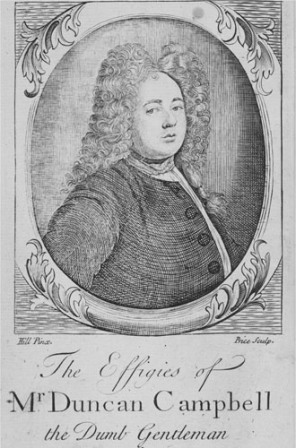
11
Duncan Campbel's portrait, from his
Secret Memoirs
, sports a magnificent wig that emphasizes his respectability. The absence of occult symbols is notable, but emphasis is placed on Campbel's eyes, which served as his conduit to predicting the future. He is a polite prophet, not a magician.
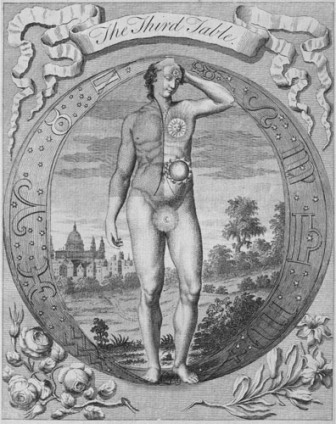
12
The third of A.D. Freher's “Three Tables,” showing Man moving towards a spiritual or regenerated state, as illustrated in the third volume of
The Works of Jacob Behmen
(1772). These elaborate cutout engravings were arranged in multiple folded layers that could be lifted up to reveal changes to the body and the spirit. As each layer was raised, the appearance and spiritual organs of the earthly Man progressively degenerated and then were gradually restored. In keeping with Freher's original designs, the figures are surrounded by astrological signs and the stages in their transformations are represented by celestial or alchemical symbols.
